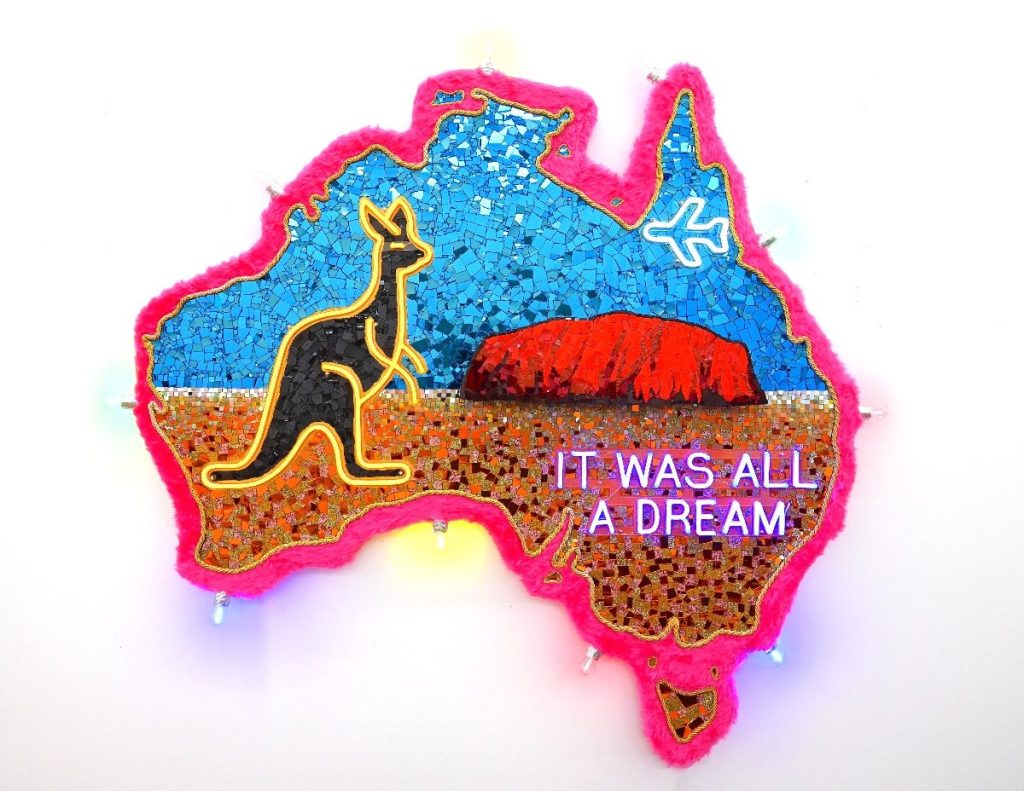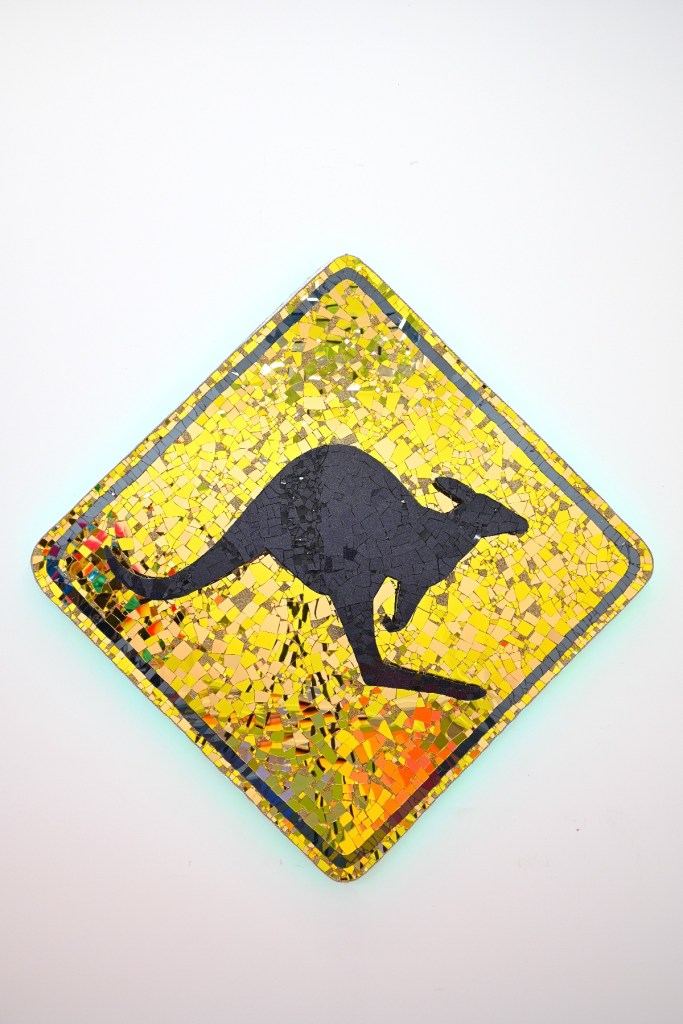Do they really know the place we call home?
Through a sea of broken glass at Hugo Michell Gallery, Paul Yore examines what it means to be Australian beneath the shimmering surface of our international advertising campaigns.

What makes a place worth remembering? What do you take away from it?
Australia’s icons are recognised all around the world, flaunted in brochures and advertisements overseas, and across keyrings, magnets and hats from here to Gundagai. But those who live here know that patriotism isn’t straightforward, and things aren’t as easy as they might seem from the outside.
In Souvenir, contemporary Australian artist Paul Yore blows up, to a size characteristic of this enormous continent, some of our most famous symbols while allowing us to scrutinise our homeland.
A reprieve from the gloomy winter’s day outside, the luminous theatricality immediately evokes the spirit of Priscilla, Queen of the Desert. Up close, the mosaicked sculptures are elaborate and intricate, and despite an alluring veneer, the glow reveals the cracks, a brokenness, something more to be discovered.

You might like
Key work, Uluru (It Was All A Dream), stuns with hundreds of cerulean fragments combining to form a clear sky, and thousands in shades of ochre and gold form the outback sands. Somehow, their blending together and glittering under the LED bulbs feels genuine rather than an exaggeration of our natural landscapes.
‘IT WAS ALL A DREAM’ the piece reads, inviting many interpretations. A reference to the diverse spiritual systems of First Nations communities, often labelled ‘Dreaming’? Or perhaps their shattered dreams at the hands of colonialism (Yore worked on Souvenir in the wake of the Voice to Parliament referendum)? Or the very idea that Australia isn’t ‘real’ because sovereignty was never ceded?
It could also hark back to the same-sex marriage plebiscite of 2017 – a dream of the LGBTQIA+ community finally realised.
Queerness is an unerasable force in Uluru, through the fluffy pink border and golden cord that line the unique shape of the continent, and the sensational mix of unabashed colour and sparkle within.
Subscribe for updates

This subtext reappears in arguably the star of the show, Sign (Kangaroo), which puts our national emblem on the runway. Yore flips the common yellow road sign cautioning drivers from a warning into a celebration. Warm golden shards interlock to provide a texturally luxurious sunset, and when the light hits the glass just right, a scorching outback sun appears.
The roo has depth too, no longer black and flat, but appearing like coffee grounds speckled with red, green and silver, taking centre stage. However, the sharpness of the glass also reminds us of the danger and death facing the legendary marsupial – often ending up as roadkill, or the victim of a farmer’s rifle.
The shiny reflectiveness allows the viewer to contemplate this as they see themselves mirrored back, glossy but sliced by the multifaceted material.
Yore takes a softer approach in his series of Koala tapestries, where he leans into kitschness and his love of collecting and collage. A koala and her offspring, which is reminiscent of Madonna and Child (a reference to the artist’s religious upbringing) are embroidered – a reclaiming of an art traditionally considered of low value and undertaken by elderly women. He hasn’t missed a trick: the maternal figures are finished with manicured claws.
The stitched image is bordered by a treasure trove of found materials – from shells to beer lids, a sunglass lens and computer key, coins and gumnuts – evoking a strong sense of childhood and comfort, consolidated with festive fairy lights.
Souvenir may lack the confronting provocation and controversy of Yore’s previous collections, but these subtle acts of reconstructing and reclaiming are powerful.
As for redefining this place, as another work in Souvenir proclaims, ‘FEELING IS THE TRUTH’.
Souvenir is showing at Hugo Michell Gallery until June 14.
Sarah Herrmann is the latest recipient of the Helpmann Academy InReview Mentorship. She is working with experienced visual arts writer Jane Llewellyn to write a series of articles for publication in InReview, funded by the Helpmann Academy.
Free to share
This article may be shared online or in print under a Creative Commons licence

